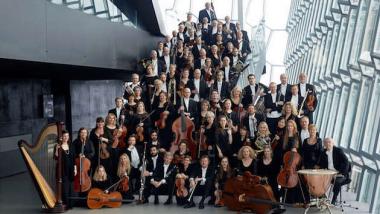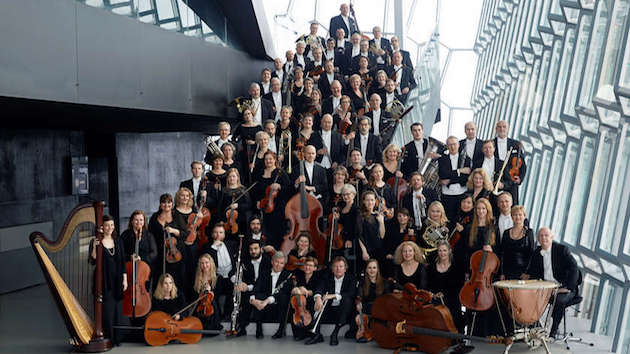
Not so long ago — no time at all, in classical music terms, where the time scale is reckoned in centuries — Iceland was entirely off the radar, so far as the international musical world was concerned. True, collectors of musical arcana may have run into Sveinbjörn Sveinbjörnsson, a student of Carl Reineke whose career straddled the 19th and 20th centuries, and who composed some lovely chamber works (as well as the Icelandic national anthem). But until recently, that was about it.
There are classical performers with Icelandic connections — most notably Vladimir Ashkenazy, who became an Icelandic citizen in 1927, four years after he settled there upon leaving his native Russia. And if you check the rosters of chamber ensembles and orchestras, you’ll run into Icelandic names, which typically end in either “son” or “dottir,” indicating the bearer’s gender, the first part of the name being their father’s given name. (Since there are no family names, as such, Icelandic phone books list people by their first names.)
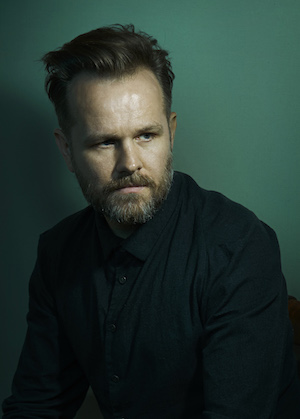
It was pop music that first drew the spotlight to Iceland, thanks to the Sugarcubes, which thrived between 1986 and 1992, and its singer, Björk, who has been thriving ever since, as well as Sigur Rós, a band that — given its compositional quirkiness and the fluidity of instrumentation among modernist composers now — could, for all practical purposes, be considered a new-music ensemble. In fact, the country’s hot record label and artist collective, Bedroom Community, founded in 2006 and run by the Icelandic composer Valgeir Sigurðsson, records musicians from either side of the pop-classical divide — a boundary that is increasingly porous, internationally, and seems scarcely to exist at all in Iceland.
That said, a handful of recent releases devoted to Icelandic orchestral and electronic music shows that the country’s composers have distinctive styles that, personal and variable as they are from one composer to the next, nevertheless share certain elements that register as a kind of Icelandic lingua franca.
The most striking of these is the use of background drones — sustained single tones, chordal textures, washes of electronic white or pink noise, and even, at times, chord progressions that move so slowly that each chord functions as a drone for an extended period. Unlike the drones that accompany Indian music, the Icelandic kind is usually quiet, hazy, and distantly atmospheric. Think of them as nimbus-like backdrops against which the music’s action unfolds, or perhaps, a modernist twist on the basso continuo.
Intended or not, this music often has a picturesque quality, as well: dark, moody, and intense, and more typically slow and quiet than fast and loud; these works seem almost to evoke the country’s otherworldly landscapes. The music’s foreground events, set against the drones, tend to be spare and shimmering. And the composers appear to prize texture and changeability over such conventional elements as recurring, long-lined themes and structural guideposts.
Nordic Affect, an Icelandic chamber group devoted to its country’s new music, invited three composers to contribute two works each — one electronic, one for the group to perform — to its illuminating Raindamage [Sono Luminus] collection. At times, the timbral lines are so blurred that you would be hard pressed to say whether the sounds are acoustic.
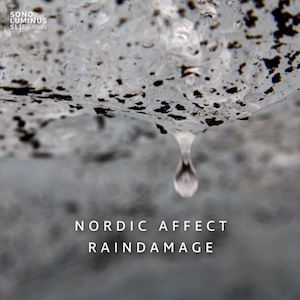
The eerily glassy string clusters, high-pitched staccato harpsichord tones, and breathy percussive sounds that Hlynur Aðils Vilmarsson uses in [:n:], his instrumental piece, for example, are not a universe away from the electronic textures from which he built noa:ems, although there are moments in each — the pointillistic violin figures and bow-bouncing in [:n:], and the growling sounds, R2-D2-like bleeps, and birdhouse sounds in noa:ems — that are less equivocal.
Both pieces are painterly, in a Paul Klee kind of way. Úlfur Hansson’s Þýð, for violin, viola, cello, and voices, strikes me as closer in spirit to Jackson Pollack. Such descriptions are wholly subjective, obviously, but they are also the inevitable associations a listener is likely to make when music this thoughtfully constructed jettisons such traditional elements as themes and structures, and instead focuses on constantly changing timbres, sudden gestures that burst into the foreground and disappear, never to be encountered again. Hansson’s electronic piece, Skin Continuum, is easier to describe, since his timbres are mostly percussive, and sound entirely acoustic, like gentle, increasingly varied (and speedier) tapping on a resonant drum head, or later in the work, on glass.
The two most compelling works here are by Valgeir Sigurðsson, who did not entirely comply with the project’s guideline of providing one electronic and one instrumental work. His Raindamage, the album’s title piece (and opener) is scored for violin, viola, cello, and electronics. But the instruments hold the foreground, in sullen, dark-hued dialogues underpinned, near the end, by a tolling bass tone and punctuated by short, high-pitched, pianissimo beeping.
Sigurðsson’s fully electronic piece, Antigravity, begins with a gentle, gradually expanding wash of sound that persists through the work, sometimes becoming an ambient roar, elsewhere receding as a play of repeating bass tones, electronic crackle, whistles and scraping sounds rise and fall within the texture.
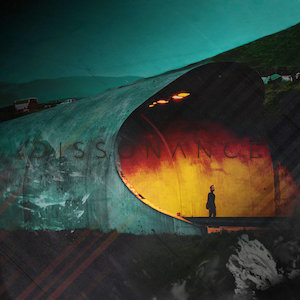
Sigurðsson has also just released Dissonance [Bedroom Community], his fourth collection of his own works, both electronic and acoustic, and his first since the fascinating Architecture of Loss, five years ago. Sigurðsson’s recording method is unusual, by classical standards: he records small groups of musicians from the Reykjavík Sinfonia — five or six at a time, he has said in interviews — layering them individually in a series of multitrack overdubs. This gives him considerable freedom when mixing the finished piece.
If you listen to the album’s title track only superficially, you might wonder why he needs that flexibility, since much of the work appears to be little more than a drone. But it’s actually quite a lot more than that. Though an undulating haze runs through the work, the piece is anything but static; in fact, it’s pure Mozart. Well, almost. Sigurðsson based the piece on the introduction of Mozart’s Quartet No. 19 in C (K. 465), and pilfered that work’s nickname for his title. But where Mozart spends about 90 seconds on this introspective passage, Sigurðsson dwells on its already slow-moving harmonic changes for nearly 23 minutes.
His four-movement No Nights Dark Enough draws on antique musical DNA as well, in this case John Dowland’s Lachrymae, which was also known, in its vocal version, as “Flow My Tears.” You hear those tears, rather than the Dowland melody, as such, in the first movement, Flow, as descending string glissandi. This is busy work, with fairly brisk, seductive chord shifts and dramatically changing layers of morphing, tactile electronic sound, mostly heard (with the exception of the electronic third movement, Infamy Sings) within the orchestral fabric.
The closing work, 1875, is more dramatic still. Cast in three movements, it commemorates the founding of New Iceland, an Icelandic community near Lake Winnipeg, in Canada, after a cataclysmic volcanic eruption in Iceland forced nearly a quarter of the island’s inhabitants to flee. Here, within drones and harmonic vagaries of the modern Icelandic style, Sigurðsson creates an evocative, vividly picturesque narrative. Within the glittering haze of Waterborne, the first of the work’s three movements, you get a visceral sense of the sea voyage from Iceland to Canada, while the central movement, In the Dead of Winter builds to an almost Wagnerian heft (with some Glassian repeating figures within the grand orchestral fabric), and the finale, Displaced, is alternately contemplative and unsettled.
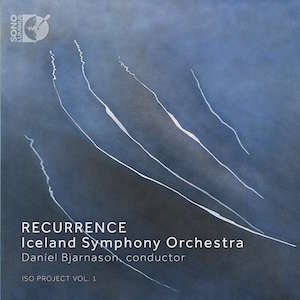
A third collection, the Iceland Symphony Orchestra’s Recurrence [Sono Luminus], brings together scores by five composers, including Daniel Bjarnason, who conducts the set. Bjarnason’s three-movement Emergence is etched partly in the same melancholy string textures and seascape imagery as some of Sigurðsson’s music, but that is only part of the picture. All three movements climb out of the haze and blossom into intensely dramatic passages, full of chordal swells and percussive thunder.
Maria Huld Markan Sigfúsdóttir’s Aequora uses some of the same elements — the pianissimo distant drone, the balance of strings and percussion, waves of orchestral sound — but to entirely different effect, partly because she favors pitched percussion over timpani (although you hear them rumbling at times), and partly because she writes with a graceful delicacy that draws you in. In its best moments, she seems as if she is holding an orchestral chord under a microscope, subtly changing and rebalancing it before letting it crest like a wave.
Thuridur Jónsdóttir’s Flow and Fusion and Hlynur A. Vilmarsson’s bd are rich, often violently changeable works. Both begin with a pianissimo, ghostly haze — that characteristic Icelandic drone — but each heads toward a harmonically spiky, complex realm in which dreamy figures turn nightmarish, and near-silences give way to eruptions of dense, percussive textures.
Anna Thorvaldsdottir’s Dreaming, by contrast, closes the disc more calmly, or at least, quietly. Now and then, short timpani blasts disturb the peace, but for the most part, Dreaming is a refined, richly detailed but subdued meditation, in which every department of the orchestra is nearly always in full view, but in constantly shifting relationships with each other. Gentle, pitched percussion figures, abrasive bowing effects, and short wind bursts keep the fabric bristling, and the overall effect is so mysterious that when the piece ends, your immediate impulse is to play it again.

